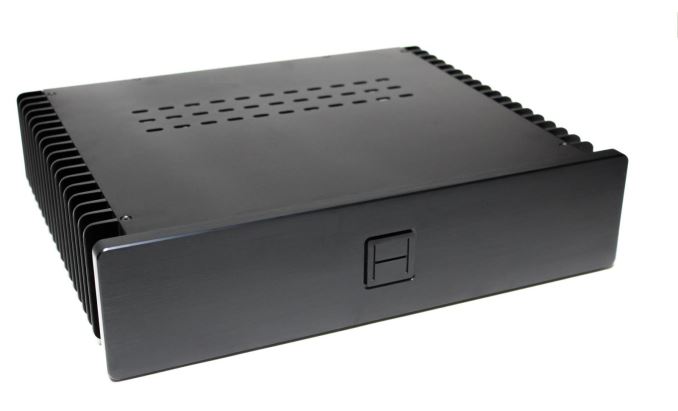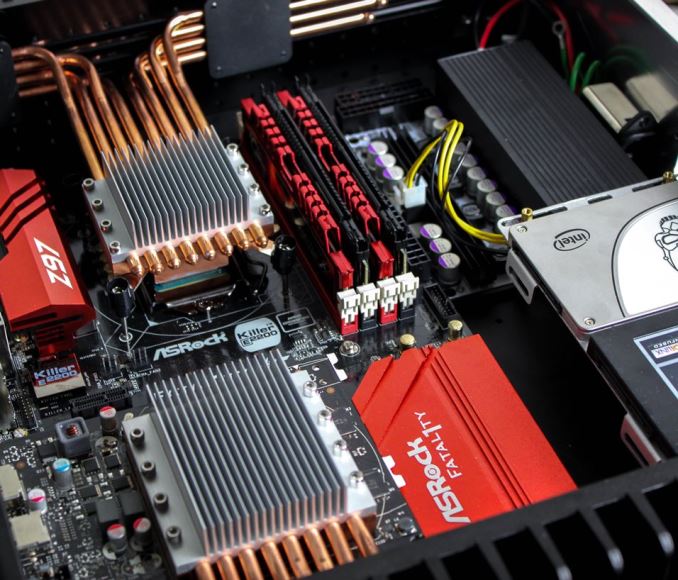HDPLEX Unveils 2nd Generation H5 Passive PC Chassis
by Ganesh T S on September 15, 2015 10:30 PM EST- Posted in
- Systems
- Cases/Cooling/PSUs
- Fanless
- HTPC
- Passive Cooling

The advent of CPUs with low TDPs (but having enough power to handle HTPC duties) has resulted in passive HTPCs becoming more and more popular. There are a number of vendors making a play in this niche such as Streacom, Wesena, Perfect Home Theater and HDPLEX. We even looked into the Streacom FC10 in detail with a passively cooled Ivy Bridge HTPC build. I have also been using the HDPLEX H5.TODD in a passive Haswell HTPC and had a good experience during the build process.
Olivier at FanlessTech brought the news of the unveiling of the second generation H5 chassis to our notice. This looks to be one of the more ambitious passively cooled chassis in the market. The new H5 chassis maintains a sleek look and finish suitable for and has a HTPCs, while also retaining standard AV rack compatibility. The chassis is made of 6063T aluminum alloy and has a powder coated finish. While the body is available in black, the faceplate can be either black or silver. The faceplate itself has a brushed aluminum finish. Internally, the chassis supports a eight-pipe heatsink for the CPU. This configuration can apparently handle CPUs with TDPs of up to 90W. ATX, uATX and mITX boards are all supported.
The specifications of the 2nd generation H5 model are summarized in the table below.
| HDPLEX 2nd Gen. H5 Passive Chassis Specifications | ||
| Motherboard Form Factors | ATX, Micro-ATX and Mini-ITX | |
| Drive Bays | Optical | 1x 5.25" ODD / hotswap HDD cage |
| Internal | 3x 3.5", 6x 2.5" | |
| Cooling | Eight-heatpipe heatsink system for the CPU Optional eight-heatpipe heatsink system for a discrete GPU |
|
| Expansion Slots | 1x full height (single slot) 1x half height single slot(no riser needed) 1x dual slot (for discrete GPU) |
|
| I/O Ports | 2x USB 3.0 2x USB 2.0 1x 3.5mm Speaker Port 12V/5VDC via molex output for external HDD enclosures Rear I/O list is motherboard dependent |
|
| PSU Compatibility | 80W/160W internal AC-DC adapters 160W/250W DC-ATX power supplies 100W/300W linear ATX power supplies with 19V/12V/9V/5VDC outputs SFX form factor ATX power supplies Flex form factor ATX power supplies |
|
| Weight | 7.5 kg / 16 lbs. | |
| Dimensions | Internal 345x370x75mm (L x W x H) External 345x430x80mm (L x W x H) Faceplate 430x80x15mm(L x W x D) |
|
| Price | from $275 | |
One of the interesting aspects is that the faceplate is pivotable, and the ODD/HDD cage can be completely hidden behind it. The main differentiating aspect, in our opinion, is the availability of passive cooling capabilities for discrete GPUs with TDPs up to 60W (such as the NVIDIA GTX 750Ti). This is achieved using a separate eight-pipe heatsink (as shown in the picture below).
More photographs and details are available in this HDPLEX thread.
Source: FanlessTech











16 Comments
View All Comments
mobutu - Thursday, September 17, 2015 - link
Acarney, thanks for requesting the GTX960 testing, much appreciated!A lot of folks don't understand the concept of passive/silent/quiet PC's, even anandtech tests here for noise are totally out of scale and laughable, the room they test in has a base noise level of 30db! Thats astounding high and noisy! Why would you bother with noise anymore in this highly noisy environment :)
Take SPCR (silentpcreview.com) for example, their base room noise level is 10-11db and any PC/configuration that's above 20db in full-load is rightfully considered too loud!
I'm so happy that this case will be available, one could finallly have a decent medium-gaming-powered PC totally fanless thus inaudible!
And yes, that fanless 250W from HDplex (or streacom) will keep a decent system with 960GTX in full load no problem, approx 200W total. No overclocking thou but thats not needed by most clients in this market niche.
You can look for the STRIX series from Asus, GTX960, the fans are in full-stop when doing normal PC usage, thus inaudible, only in gaming or other intensive gpu scenarios they start to ramp up.
https://www.asus.com/us/Graphics_Cards/STRIXGTX960...
Shadowmaster625 - Wednesday, September 16, 2015 - link
I think they're asking for trouble by using that 8 inch PCIe ribbon cable.jpmore - Wednesday, September 16, 2015 - link
Those 8 heatpipes look sweet, 90W is pretty impressive, but why does the CPU cooler have fins on it? Wouldn't that dump some of the heat inside the case instead of outside? From my personal experience building passive systems, they do a good job of cooling the CPU, but internal heat does take its toll on motherboard and drive temperatures.mobutu - Wednesday, September 16, 2015 - link
Both Heatsinks (CPU+GPU) have fins in order for cooling through natural convection also. he heat will go up and excape thru the holes in the top of the case.Flunk - Wednesday, September 16, 2015 - link
This looks like it would be good for industrial or sound production purposes or as a media computer (although you don't really need an entire PC for that anymore).ruthan - Wednesday, September 16, 2015 - link
Well total passive build is so expensive that im always thinking about next room / closet PC and long cables and wall penetrating..But it needs also some problems to solve, which are probably fixable:
- long monitors cable - i need lots of them - im using all 8 outputs on my monitors (yeah im gamer) - so there are VGA, Component and Composite, DVI, HDMi and Displayport cables able to deliver signal without degradation at 8, 10 meters distance?
- powered USB3 hub - for DVD / Blue-ray, keyboards, mouse, flash drives etc, maybe monitor one cable used
- how to reset computer remotely, i know that there is something like keyboard power up, but i dont know how much it is reliable and i dont know to reset through keyboard - yeah i could - turn off and turn on - but is a bit lame. Fix could be something like wireless switcht and remote, but im not fan of soldering, so i would like to buy something for that.
And this - remote start up part need to solved also for console, which are far more noisy than my rig.